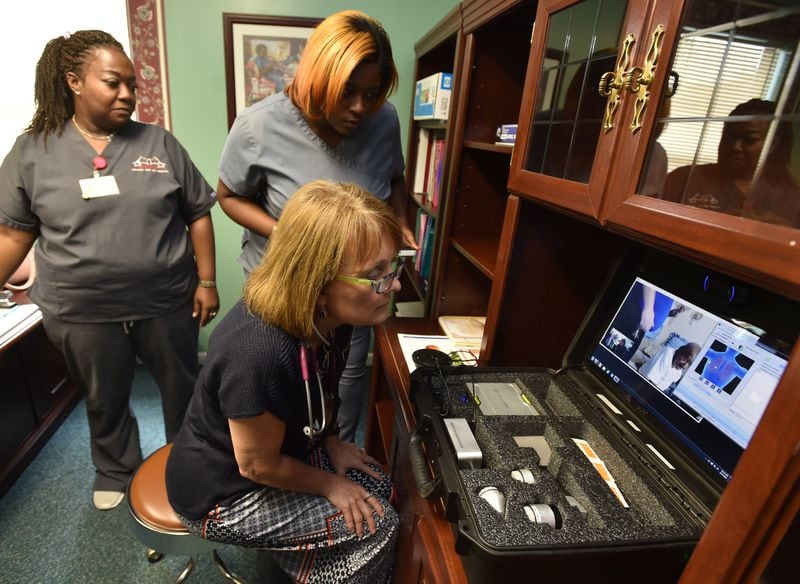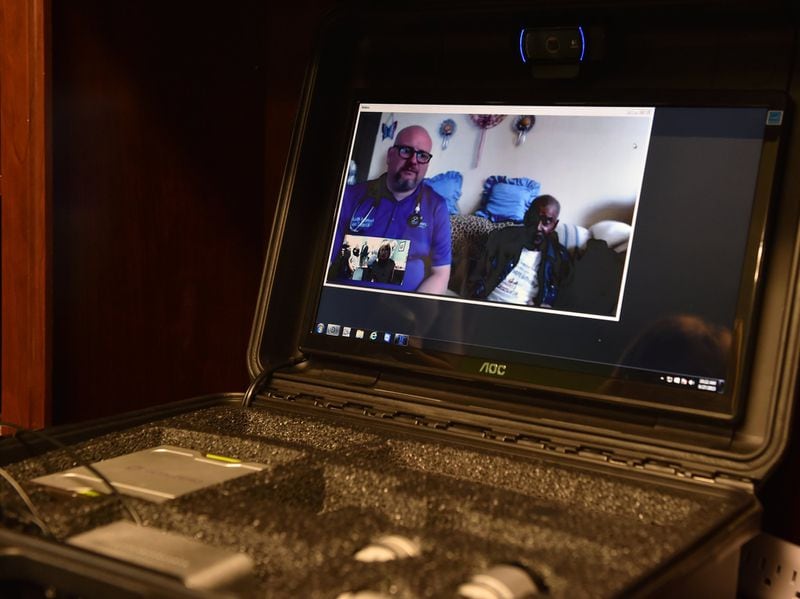Hancock County, home to 9,000 or so Georgians, has long been known in the state for being at the bottom in many measures of well-being.
Its county seat, Sparta, just over 100 miles southeast of Atlanta by way of I-20, is so decimated by economic decline and an aging population that it has more funeral homes (two) than hospitals (zero).
“Parents don’t even want their grandkids to visit us, because if something happened to them, we couldn’t get ‘em to a hospital quick,” said lifelong resident Ida Ransom, 72.
But a grand experiment is underway in Sparta, one that health care experts, state legislators, local leaders, Mercer University School of Medicine officials and concerned citizens hope will become a model for the nation.
The Hancock Rural Healthcare Initiative, an ambitious telemedicine program, equips ambulances with computers, cameras, electrocardiogram leads and 4G cards that allow EMTs to share patient information in real time with hospital emergency room doctors in neighboring counties.
The EMT can move the equipment from the ambulance into the patient’s home, as needed.
The ER doctor can then determine how best to treat the patient — whether at home or en route to the hospital.
Hancock isn’t devoid of care for chronic or occasional maladies. There is a federally qualified health center in Sparta whose nurse practitioners provide treatment during basic office hours, regardless of a patient’s insurance status or ability to pay.
But the health center doesn’t have a doctor. And since many people in Hancock lack transportation, even a Sparta-based facility can be hard to reach, especially for someone in a wheelchair.
“We don’t have urgent care, we don’t have much of any care,” said resident Paul McGhee. “There’s a whole lot of praying going on around here.”
So the folks behind the telemedicine initiative are thrilled that it connects Hancock patients not only to ER doctors in partnering counties, but also to nurse practitioners right there in Sparta.
Some other rural systems are equipping ambulances in this way to connect to ERs, said Dr. Jean Sumner, associate dean of rural medicine at Mercer School of Medicine.
“But so far as we know, we are the only one using EMTs like this in the home,” Sumner said.
Ambulance as Rolling Hospital
The telemedicine program was facilitated by a special waiver agreement for Hancock County that allows EMTs to be reimbursed for treating patients in consultation with doctors. The program was launched this summer with a grant of $105,000 from the Georgia Department of Community Health. Its ambulances are supplied through a contract with Grady Healthcare in Atlanta.
An EMT “can do a 12-lead EKG, labs, mobile imaging, X-rays,” said Sumner, who also is a physician in nearby Sandersville.
“It’s about getting the right patient to the right care at the right time,” Sumner said.
It’s also about avoiding unnecessary trips to the emergency room. About two-thirds of ambulance trips from Hancock to nearby counties’ hospitals are for non-emergencies, Sumner said.
In effect, the ambulance becomes a rolling hospital, which can prove particularly beneficial in cases involving a stroke, a heart attack, or serious injury.
Health Care and Jobs
Changing rural health care in the state is essential, leaders of both political parties in the state said. Medical facilities are shutting down in tiny towns whose shrinking, aging populations lack sufficient income or insurance to support a hospital.
Hancock Memorial Hospital closed in 2001. Four rural hospitals in Georgia have gone out of business in the past five years, and several others are on the brink of closure. Others, such as Emanuel Medical Center in Swainsboro, have closed unprofitable units, such as labor and delivery.
But rural hospitals do more than provide health care. They also provide jobs, typically as one of their counties’ two largest employers — the other being public school systems.
That's why the telemedicine program is a tool for economic development that the county desperately needs, said state Sen. David Lucas (D-Macon), whose district includes Hancock.
“Employers can get a $3,500 tax credit for every employee they hire, but we can’t get them here if you don’t have health care,” Lucas said.
Lucas, with the backing of Gov. Nathan Deal and other rural legislators, built support for the waiver that allows EMTs to be reimbursed by Medicaid and Medicare for treating patients in Hancock County.
It had to happen, he said. “We are not a Third-World country.”
A Tale of Two Smiths
On a recent, late August morning, David Smith, 80, who uses a wheelchair to get around Sparta, was able to stay in his apartment for a physical exam. With him was an EMT who, via camera and computer, connected Mr. Smith to another Smith — nurse practitioner Kemberly Smith — who conducted her examination from an office in the federally qualified Community Health Care Systems center on Hamilton Street.
“How have you been getting along recently?” the nurse asked Smith, who has chronic obstructive pulmonary disease.
“I’ve been doing pretty good,” Smith said.
“Mr. Smith, are you using your Spiriva as prescribed every day?” the nurse asked.
“I don’t use it every day,” he said.
“You need to use your Spiriva every day,” the nurse said.
Heartbeats via Computer
Nurse Smith directed the EMT to put the stethoscope on patient Smith’s chest, over his heart. The sound of the beats came through loud and clear.
“Can we just listen to his stomach, too — his abdomen?” the nurse said.
“Can I see his feet too?”
“Let’s look at his throat,” she said next.
A monitor-sized image of Smith’s mouth, tongue and tonsils appeared on the screen within moments.
Next came images, much larger than what the nurse would have seen had Smith been in her office, of Smith’s eyes and the inside of his ears.
Everything looked good, she said.
The Warmth of Telemedicine
“So, Mr. Smith, are you feeling OK?” the nurse asked.
“I feel all right,” he said.
“Is there anything else we can do for you today? How is your appetite?”
“About as good as, you know — it’ll be good some time and some time it won’t,” he told her.
She wrapped up the appointment with another reminder that Smith needs to take Spiriva every day.
“Good to see you today, Mr. Smith,” the nurse said.
“Good to see you too, Miss,” Smith said.
Sitting in his motorized wheelchair outside his apartment later, Smith said he was pleased with the appointment.
“I liked it fine,” he said, adding that he hopes to have a telemedicine visit next time.
“It’ll keep from being out in the cold in the winter.
About the Author







